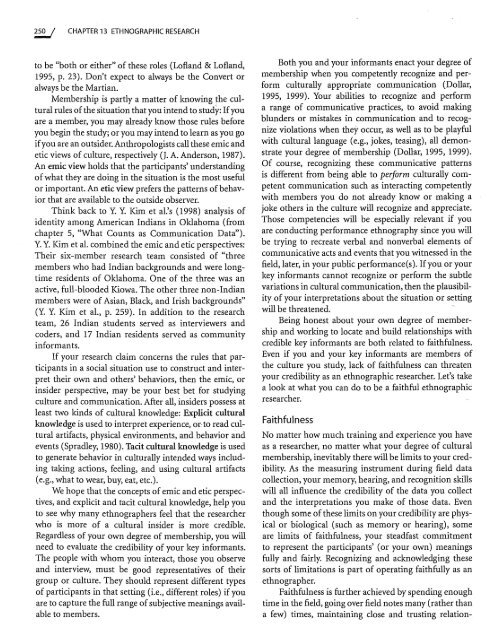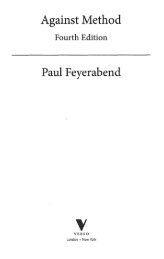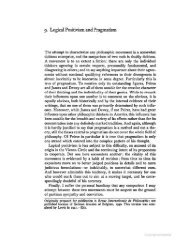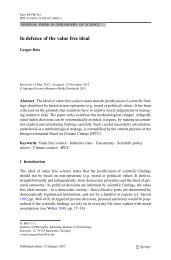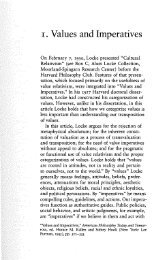Ethnographic Research - Matthew J. Brown
Ethnographic Research - Matthew J. Brown
Ethnographic Research - Matthew J. Brown
- No tags were found...
Create successful ePaper yourself
Turn your PDF publications into a flip-book with our unique Google optimized e-Paper software.
~ CHAPTER 13 ETHNOGRAPHIC RESEARCHto be "both or either" of these roles (Lofland & Lofland,1995, p. 23). Don't expect to always be the Convert oralways be the Martian.Membership is partly a matter of knowing the culturalrules of the situation that you intend to study: If youare a member, you may already know those rules beforeyou begin the study; or you may intend to learn as you goif you are an outsider. Anthropologists call these emic andetic views of culture, respectively 0. A. Anderson, 1987).An emie view holds that the participants' understandingof what they are doing in the situation is the most usefulor important. An etie view prefers the patterns ofbehaviorthat are available to the outside observer.Think back to Y. Y. Kim et al.'s (1998) analysis ofidentity among American Indians in Oklahoma (fromchapter 5, "What Counts as Communication Data").Y. Y. Kim et al. combined the emic and etic perspectives:Their six-member research team consisted of "threemembers who had Indian backgrounds and were longtimeresidents of Oklahoma. One of the three was anactive, full-blooded Kiowa. The other three non-Indianmembers were of Asian, Black, and Irish backgrounds"(Y. Y. Kim et al., p. 259). In addition to the researchteam, 26 Indian students served as interviewers andcoders, and 17 Indian residents served as communityinformants.If your research claim concerns the rules that participantsin a social situation use to construct and interprettheir own and others' behaviors, then the emic, orinsider perspective, may be your best bet for studyingculture and communication. After all, insiders possess atleast two kinds of cultural knowledge: Explicit culturalknowledge is used to interpret experience, or to read culturalartifacts, physical environments, and behavior andevents (Spradley, 1980). Tacit cultural knowledge is usedto generate behavior in culturally intended ways includingtaking actions, feeling, and using cultural artifacts(e.g., what to wear, buy, eat, etc.).We hope that the concepts of emic and etic perspectives,and explicit and tacit cultural knowledge, help youto see why many ethnographers feel that the researcherwho is more of a cultural insider is more credible.Regardless of your own degree of membership, you willneed to evaluate the credibility of your key informants.The people with whom you interact, those you observeand interview, must be good representatives of theirgroup or culture. They should represent different typesof participants in that setting (i.e., different roles) if youare to capture the full range of subjective meanings availableto members.Both you and your informants enact your degree ofmembership when you competently recognize and performculturally appropriate communication (Dollar,1995, 1999). Your abilities to recognize and performa range of communicative practices, to avoid makingblunders or mistakes in communication and to recognizeviolations when they occur, as well as to be playfulwith cultural language (e.g., jokes, teasing), all demonstrateyour degree of membership (Dollar, 1995, 1999).Of course, recognizing these communicative patternsis different from being able to perform culturally competentcommunication such as interacting competentlywith members you do not already know or making ajoke others in the culture will recognize and appreciate.Those competencies will be especially relevant if youare conducting performance ethnography since you willbe trying to recreate verbal and nonverbal elements ofcommunicative acts and events that you witnessed in thefield, later, in your public performance(s). If you or yourkey informants cannot recognize or perform the subtlevariations in cultural communication, then the plausibilityof your interpretations about the situation or settingwill be threatened.Being honest about your own degree of membershipand working to locate and build relationships withcredible key informants are both related to faithfulness.Even if you and your key informants are members ofthe culture you study, lack of faithfulness can threatenyour credibility as an ethnographic researcher. Let's takea look at what you can do to be a faithful ethnographicresearcher.FaithfulnessNo matter how much training and experience you haveas a researcher, no matter what your degree of culturalmembership, inevitably there will be limits to your credibility.As the measuring instrument during field datacollection, your memory, hearing, and recognition skillswill all influence the credibility of the data you collectand the interpretations you make of those data. Eventhough some of these limits on your credibility are physicalor biological (such as memory or hearing), someare limits of faithfulness, your steadfast commitmentto represent the participants' (or your own) meaningsfully and fairly. Recognizing and acknowledging thesesorts of limitations is part of operating faithfully as anethnographer.Faithfulness is further achieved by spending enoughtime in the field, going over field notes many (rather thana few) times, maintaining close and trusting relation-


